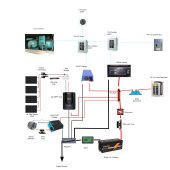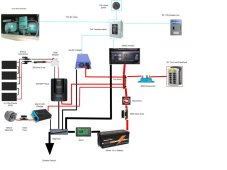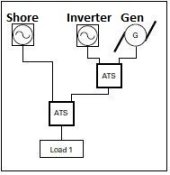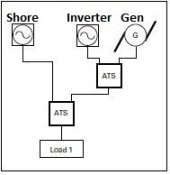kbeefy
New Member
Rough draft for the 1978 motorhome.
EDIT: Added multiple Transfer Switches and rerouted some 110. Added Switch to Sense wire of DC-DC Charger.
Edited plan:

Original:

Pardon my google drawing skills, alot of you have some amazing diagrams!
I know I cheaped out on a couple of the components, this is still by far the largest and most complex solar I've put together. I had to cut a few corners to still eat dinner.
Pretty much all will be new install except the inverter, Transfer switch, Generator, and both RV fuse/breaker panels.
Solar Panels are en route from Rich solar, Planning on running series/parallel through a breaker to a renogy 40A MPPT.
Vehicle alternator to a renogy 40A DC-DC charger. This will be set at half throttle until I upgrade the alternator and wiring.
Ampretime 200aH 12v lithium battery with a renogy shunt/displav for simple monitoring.
Battery Protect between the positive buss and 12v loads.
Existing Onan Generator, Heart Interface Inverter and 110v shore power are already wired to a pair of AC transfer switches.
I will be adding an AIMS 75A converter/charger for shore power and generator charging.
The only significant inverter load at this time is a microwave. I'm use to boondocking w/o 110v so having it available will be a learning experience for us.
I am only planning on using the AC on shore or generator power, I know I don't have the battery or inverter to handle that sort of load.
I haven't yet worked out all the wire size or lengths yet as I haven't settled on a location for everything yet.
Let me know if you see any problems or omissions, Thanks!
EDIT: Added multiple Transfer Switches and rerouted some 110. Added Switch to Sense wire of DC-DC Charger.
Edited plan:

Original:

Pardon my google drawing skills, alot of you have some amazing diagrams!
I know I cheaped out on a couple of the components, this is still by far the largest and most complex solar I've put together. I had to cut a few corners to still eat dinner.
Pretty much all will be new install except the inverter, Transfer switch, Generator, and both RV fuse/breaker panels.
Solar Panels are en route from Rich solar, Planning on running series/parallel through a breaker to a renogy 40A MPPT.
Vehicle alternator to a renogy 40A DC-DC charger. This will be set at half throttle until I upgrade the alternator and wiring.
Ampretime 200aH 12v lithium battery with a renogy shunt/displav for simple monitoring.
Battery Protect between the positive buss and 12v loads.
Existing Onan Generator, Heart Interface Inverter and 110v shore power are already wired to a pair of AC transfer switches.
I will be adding an AIMS 75A converter/charger for shore power and generator charging.
The only significant inverter load at this time is a microwave. I'm use to boondocking w/o 110v so having it available will be a learning experience for us.
I am only planning on using the AC on shore or generator power, I know I don't have the battery or inverter to handle that sort of load.
I haven't yet worked out all the wire size or lengths yet as I haven't settled on a location for everything yet.
Let me know if you see any problems or omissions, Thanks!
Last edited:




